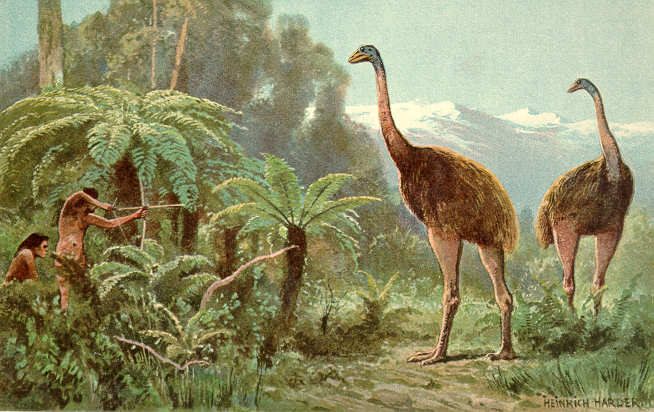What Fossilized Poop Tells Us About an Extinct Giant Bird From New Zealand
Resurrecting the moa’s diet.

The now-extinct moa holds a certain fascination for many ornithologists, New Zealanders, and, unsurprisingly, New Zealand ornithologists. Resembling a giant emu, individuals belonging to the largest species of this bird were 12 feet tall and weighed over 500 pounds. By the time the first human settlers arrived, in the 13th century, there were almost 60,000 of them. They strutted. They snacked. They very likely squawked. Then, in just under a century, they were gone—hunted to extinction by humans overwhelmed by an all-too-convenient food source.
There are still many questions about these fluffy giants that remain unanswered—why they didn’t fly, for instance, or what they ate. New research on ancient DNA found in their fossilized dung helps answer some of them. The moa, it turns out, had a taste for mushrooms and other fungi, along with mosses and ferns. (Big birds need big breakfasts.)
Researchers from Landcare Research and the Universities of Auckland and Adelaide analyzed samples of coprolites (another term for fossilized poop) collected from locations across the South Island by deciphering the ancient DNA locked inside them. Their analysis appears in Proceedings of the National Academy of Sciences.
Of the four extinct moa species studied in the research, only the upland moa and the South Island moa seem to have eaten mosses and ferns. The upland moa also carried a revealing parasite, which researchers said could only have been obtained by eating pond snails or aquatic plants, likely from mountain lakes in alpine areas. It’s possible, Science magazine reports, that this smaller moa focused on foods its larger cousins ignored.
But in all the samples, fungus proliferated—particularly bracket fungi, that sit like shelves on the trunks of trees, or swollen puffballs. The birds also ate mushrooms as brightly colored as any flower, and then spread their spores around New Zealand’s ancient forests. The birds’ absence may have changed the physical landscape too, Alan Cooper, from the University of Adelaide, told Science. “The forest has potentially lost a potentially major way to spread.”

















Follow us on Twitter to get the latest on the world's hidden wonders.
Like us on Facebook to get the latest on the world's hidden wonders.
Follow us on Twitter Like us on Facebook